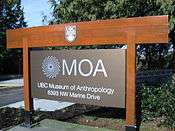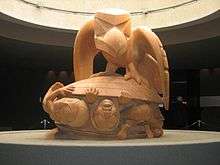Museum of Anthropology at UBC
|
| |
 Location in Vancouver | |
| Established | 1947 |
|---|---|
| Location | 6393 NW Marine Dr, Vancouver, British Columbia, Canada |
| Coordinates | 49°16′10″N 123°15′35″W / 49.269366°N 123.259596°W |
| Type | First Nations culture |
| Director | Anthony Shelton |
| Website | Museum of Anthropology |
| Part of a series on the |
| Anthropology of art, media, music, dance and film |
|---|
|
Basic concepts |
| Social and cultural anthropology |
The Museum of Anthropology at the University of British Columbia (UBC) campus in Vancouver, British Columbia, Canada is renowned for its displays of world arts and cultures, in particular works by First Nation band governments of the Pacific Northwest.[1] As well as being a major tourist destination, MOA is a research and teaching museum, where UBC courses in art, anthropology, archaeology, conservation, and museum studies are given. MOA houses 38,000 ethnographic objects, as well as 535,000 archaeological objects in its building alone.[2]
Location
The museum is at 6393 NW Marine Dr, on the campus of the University of British Columbia. MOA and UBC lie on the University Endowment Lands, which are not officially part of the City of Vancouver.
History
.jpg)

The museum was founded in 1947 when the items in UBC's ethnographic collection were put on display in the basement of the Main Library. Dr. Harry Hawthorn served as the first director of the new museum, with his wife, Dr. Audrey Hawthorn, serving as its first curator.
In 1971, the museum received funds from the Government of Canada and UBC to begin construction of a building. In 1976, the new building, designed by renowned Canadian architect Arthur Erickson, opened under new director Michael M. Ames, who served from 1974 to 1997. Walter and Marianne Koerner's 1975 donation of their extensive collection of Northwest Coast First Nations art to the museum formed a large part of the building's contents.
In 1997, Dr. Ruth Phillips became Museum director. In 2002, Ames returned as acting director. Dr. Anthony Shelton became director in 2004.
On January 23, 2010, MOA celebrated the completion of its multi-year, multimillion-dollar renovation and expansion project, "A Partnership of Peoples."
The new facilities were developed with MOA by UBC Properties Trust and designed by Arthur Erickson and Stantec Architecture. The project comprises several complementary components:
- A new wing, the MOA Centre for Cultural Research, with state-of-the-art collections storage, research rooms, archaeology labs, a community research suite, open plan offices, and the Audrey & Harry Hawthorn Library & Archives.
- The Multiversity Galleries, housing more than 10,000 objects from around the world
- The 5,800 sq ft (540 m2) Audain Gallery for temporary exhibitions
- A new Café MOA and expanded shop
- The MOACAT digital catalogue system, making collections information (images, audio, and video) available throughout the galleries at the touch of a screen
- The RRN (Reciprocal Research Network), created in partnership with the Musqueam Indian Band, Stó:lō Nation, Stó:lō Tribal Council, and U'mista Cultural Society.[3]
The Museum is affiliated with CHIN, CMA, and Virtual Museum of Canada.
Legacy
On 9 March, 1999, Canada Post issued a stamp commemorating the museum, designed by Barbara Hodgson, based on photographs by William McLennan and Jacqueline Gijssen, and prominently featuring the sculpture The Raven and the First Men by Bill Reid. The 46¢ stamps are perforated 13.5 and were printed by Canadian Bank Note Company, Limited. [4]
Building
Arthur Erickson's building, designed in 1976, was inspired by the post-and-beam architecture of northern Northwest Coast First Nations people. Like much of Erickson's work, the building is made primarily out of concrete. The building takes advantage of second world war gun emplacements, with the famous Bill Reid Raven sculpture located on a repurposed gun battery.
In September 2010, a reflecting pool was added to the front, funded by Yosef Wosk, OBC. Arthur Erickson and landscape architect Cornelia Oberlander originally intended the pool to be opened as part of the new Museum of Anthropology in 1976; now, nearly 35 years later, their original vision for MOA has been fulfilled. Pools had been installed temporarily three times in MOA’s history: for a movie shoot in 1993, for the APEC leaders’ summit in 1997, and to celebrate Arthur Erickson’s 80th birthday in June 2004.[5]
Highlights

_MOA_'Imich_Siiyem'_figure.jpg)
The most iconic object in the museum is probably the yellow cedar sculpture The Raven and the First Men by Bill Reid, which was depicted on the Canadian twenty-dollar bill from 2004 to 2012 (the Canadian Journey Series).
Other notable Bill Reid works include his Bear and Wasco (Sea Wolf) sculptures, some of his gold jewellery, and a prototype of the Haida dugout canoe he carved for Expo 86.
The museum contains several large Musqueam artifacts from the late nineteenth and early twentieth centuries, as well as many contemporary works commissioned from Musqueam artists such as Susan Point, Joe Becker, and Robyn and Debra Sparrow.
The museum's Great Hall contains many fragments of totem poles from Haida and other First Nations villages along British Columbia's coast.
The MOA has an extensive collection from the South Pacific.
There are about 6000 textiles in the collection; about half of these come from Asia. Of particular note are the Cantonese opera costumes that are considered some of the world's finest. There are excellent holdings from the Northwest Coast, Oceania, Africa, and South America.
The Audrey & Harry Hawthorn Library and Archives is open to the public. The archives contain approximately 90,000 photographs that cover a wide range of cultures, ethnographic subjects, and historical events. The collection dates from the 1890s and is an important resource for researchers, writers, artists, and communities.
There are approximately 2800 objects in the African collection. The earlier collections came to MOA via missionaries, travelers, and ex-colonial officers. The collection includes masks, Yoruba thorn carvings, over 100 Makonde figures from Tanzania, approximately 100 Asante gold weights, weaponry from South Africa and about 100 mortuary objects from Egypt.
About 40% of MOA's collection is from Asia. The Chinese collections include between 1000 and 1500 pieces of Chinese ceramics, Chinese calligraphy, and paintings (with four recently identified masterpieces from the collection of Ho Ping-ti). In addition, there is a large collection of Japanese prints, Buddhist art, Hindu art (including Gandhara sculpture), textiles and clothing, and Indian calendar prints. Other collections include 2300 Chinese coins and amulets, 200 Sichuan blue thread embroideries dating to circa 1900, rare Tibetan robes, and masks from Noe (Japan), Sunni and Kolam (Sri Lanka), and Pongsan and Yangju (Korea).
The Haida houses outside the museum were built under the direction of Bill Reid, who carved, with Doug Cranmer, many of the totem poles surrounding them. The original Reid/Cranmer totem pole mounted on the front of the big house was taken inside in 2000 due to deterioration and replaced with the new "Respect to Bill Reid Pole" by Haida artist Jim Hart.
The renewal project
In 2006, the Museum launched a multimillion-dollar project to create a new research wing, as well as new offices, laboratories, a culturally sensitive research room, recording studio, and a new, 5,800-square-foot (540 m2) exhibition hall: The Audain Gallery. Other enhancements included MOA's new Multiversity Galleries, the creation of the RRN (Reciprocal Research Network) linking Northwest Coast collections around the world, a relocated and expanded Museum Shop, year-round cafe, and courtyard and outdoor 'events pad' suitable for facility rentals. The project was completed in January 2010.
Budgeted at $55.5 million, the Renewal Project received $34.4 million in funding from the Canada Foundation for Innovation and British Columbia Knowledge Development Fund ($17.2 million each), the University of British Columbia, UBC Faculty of Arts, and the museum itself. Recently, MOA received a major gift of $5.5 million from the Koerner Foundation, Toronto, towards the project.
The collections
 Totem pole at the Museum of Anthropology at UBC
Totem pole at the Museum of Anthropology at UBC Wood figures at the Museum of Anthropology at UBC
Wood figures at the Museum of Anthropology at UBC First Nations totem poles and Haida houses
First Nations totem poles and Haida houses Carved figures inside museum
Carved figures inside museum Back view of museum and outdoor exhibits
Back view of museum and outdoor exhibits Native art
Native art.jpg) Haisla canoe
Haisla canoe.jpg) Haida pole
Haida pole North American art
North American art "Sea Wolf" carved by Bill Reid
"Sea Wolf" carved by Bill Reid.jpg) Arctic American shirt
Arctic American shirt.jpg) Odler dish ware (Koerner gallery)
Odler dish ware (Koerner gallery).jpg) Kendi pot (Koerner gallery)
Kendi pot (Koerner gallery).jpg) Slovak jug (Koerner gallery)
Slovak jug (Koerner gallery).jpg) Holitsch dish (Koerner gallery)
Holitsch dish (Koerner gallery)
This museum includes a number of large sculptures, totem poles, and cultural artifacts. Although MOA's focus is on the First Nations of the Northwest Coast, the collection of 38,000 ethnological objects includes objects from all continents. These are mostly in the Multiversity Galleries, where objects that would normally be stored behind the scenes are made accessible to the public. The collections include contemporary works as well as historical objects. In addition to the ethnographic collections, MOA houses an archaeological collection of approximately 535,000 pieces. These are managed by UBC's Laboratory of Archaeology. The Museum also has a small wing dedicated to European ceramic art works collected by the late Walter Koerner. The Koerner European Ceramics Gallery, which opened in 1990, contains over 600 European ceramics collected by Koerner, which he donated to the Museum in 1987.
References
External links
Further reading
- Mayer, Carol Elizabeth; Anthony Shelton (2009), The Museum of Anthropology at the University of British Columbia, University of Washington Press, ISBN 9781553654155 Cite uses deprecated parameter
|coauthor=(help)
| Wikimedia Commons has media related to UBC Museum of Anthropology. |